Related Research Articles

Beadwork is the art or craft of attaching beads to one another by stringing them onto a thread or thin wire with a sewing or beading needle or sewing them to cloth. Beads are produced in a diverse range of materials, shapes, and sizes, and vary by the kind of art produced. Most often, beadwork is a form of personal adornment, but it also commonly makes up other artworks.

Bead weaving is a set of techniques for weaving sheets and objects of seed beads. Threads are strung through and/or around the beads to hold them together. It can be done either on a loom or using one of a number of off-loom stitches.
Needlepoint is a type of canvas work, a form of embroidery in which yarn is stitched through a stiff open weave canvas. Traditionally needlepoint designs completely cover the canvas. Although needlepoint may be worked in a variety of stitches, many needlepoint designs use only a simple tent stitch and rely upon color changes in the yarn to construct the pattern. Needlepoint is the oldest form of canvas work.
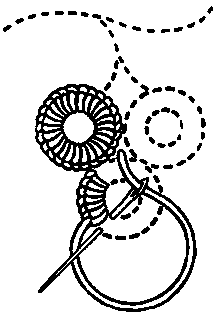
In everyday language, a stitch in the context of embroidery or hand-sewing is defined as the movement of the embroidery needle from the back of the fibre to the front side and back to the back side. The thread stroke on the front side produced by this is also called stitch. In the context of embroidery, an embroidery stitch means one or more stitches that are always executed in the same way, forming a figure. Embroidery stitches are also called stitches for short.

Darning is a sewing technique for repairing holes or worn areas in fabric or knitting using needle and thread alone. It is often done by hand, but using a sewing machine is also possible. Hand darning employs the darning stitch, a simple running stitch in which the thread is "woven" in rows along the grain of the fabric, with the stitcher reversing direction at the end of each row, and then filling in the framework thus created, as if weaving. Darning is a traditional method for repairing fabric damage or holes that do not run along a seam, and where patching is impractical or would create discomfort for the wearer, such as on the heel of a sock.
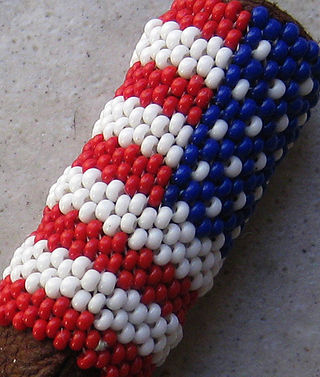
The peyote stitch, also known as the gourd stitch, is an off-loom bead weaving technique. Peyote stitch may be worked with either an even or an odd number of beads per row. Both even and odd count peyote pieces can be woven as flat strips, in a flat round shape, or as a tube. Tubular peyote is used to make pouches or to decorate objects such as bottles or fan handles.

A knitting machine is a device used to create knitted fabrics in a semi or fully automated fashion. There are numerous types of knitting machines, ranging from simple spool or board templates with no moving parts to highly complex mechanisms controlled by electronics. All, however, produce various types of knitted fabrics, usually either flat or tubular, and of varying degrees of complexity. Pattern stitches can be selected by hand manipulation of the needles, push-buttons and dials, mechanical punch cards, or electronic pattern reading devices and computers.
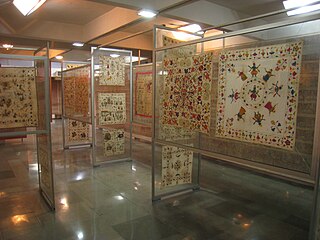
Embroidery in India includes dozens of embroidery styles that vary by region and clothing styles. Designs in Indian embroidery are formed on the basis of the texture and the design of the fabric and the stitch. The dot and the alternate dot, the circle, the square, the triangle, and permutations and combinations of these constitute the design.

Beaded knitting is a type of knitting in which the stitches are decorated with ceramic or glass beads.

Knitted fabric is a textile that results from knitting, the process of inter-looping of yarns or inter-meshing of loops. Its properties are distinct from woven fabric in that it is more flexible and can be more readily constructed into smaller pieces, making it ideal for socks and hats.

A selvage or selvedge is a "self-finished" edge of a piece of fabric which keeps it from unraveling and fraying. The term "self-finished" means that the edge does not require additional finishing work, such as hem or bias tape, to prevent fraying.
The manufacture of textiles is one of the oldest of human technologies. To make textiles, the first requirement is a source of fiber from which a yarn can be made, primarily by spinning. The yarn is processed by knitting or weaving, which turns yarn into cloth. The machine used for weaving is the loom. For decoration, the process of colouring yarn or the finished material is dyeing. For more information of the various steps, see textile manufacturing.

Brick Stitch, also known as the Cheyenne Stitch or Comanche Stitch, is a bead weaving stitch in which individual beads are stacked horizontally in the same pattern as bricks are stacked in a wall.
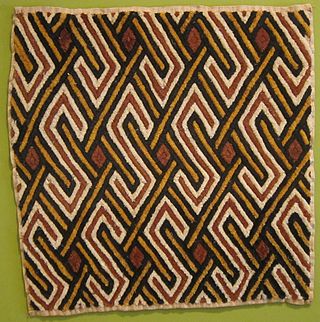
African textiles are textiles from various locations across the African continent. Across Africa, there are many distinctive styles, techniques, dyeing methods, and decorative and functional purposes. These textiles hold cultural significance and also have significance as historical documents of African design.

In sewing and embroidery, a satin stitch or damask stitch is a series of flat stitches that are used to completely cover a section of the background fabric. Narrow rows of satin stitch can be executed on a standard sewing machine using a zigzag stitch or a special satin stitch foot.

Bead crochet is a crochet technique that incorporates beads into a crochet fabric. The technique is used to produce decorative effects in women's fashion accessories. The word "crochet" is derived from the French "croche" or "croc" meaning "to hook". Published descriptions of bead crochet date from around 1824 although it was probably common before then. At one time, bead crochet was thought by some people to be appropriate only for rich people.
Square stitch is an off-loom bead weaving stitch that mimics the appearance of beadwork created on a loom. Loom patterns and even cross stitch embroidery patterns may be used for square stitch pieces. Because each bead in a square stitch piece is connected by thread to each of the four beads surrounding it, this stitch is very strong.
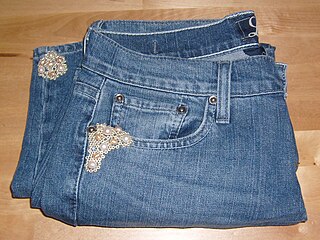
Bead embroidery is a type of beadwork that uses a needle and thread to stitch beads to a surface of fabric, suede, or leather.
Sewing is the craft of fastening or attaching objects using stitches made with needle and thread. Sewing is one of the oldest of the textile arts, arising in the Paleolithic Era. Although usually associated with clothing and household linens, sewing is used in a variety of crafts and industries, including shoemaking, upholstery, sailmaking, bookbinding and the manufacturing of some kinds of sporting goods. Sewing is the fundamental process underlying a variety of textile arts and crafts, including embroidery, tapestry, quilting, appliqué and patchwork.

Pin weaving is a form of small-scale weaving traditionally done on a frame made of pins; the warp and weft are wrapped around the pins. Pin-woven textiles have a selvage edge all the way around.
References
- ↑ Cypher, Carol (2007). Beading workshop : a comprehensive guide to off-loom techniques. Loveland, CO: Interweave Press. p. 108. ISBN 9781596680135.
- ↑ Wells, Carol Wilcox (1996). Creative bead weaving : a contemporary guide to classic off-loom stitches (1st pbk. ed.). Asheville, N.C.: Lark Books. p. 94. ISBN 1579900801.
- ↑ Blakelock, Virginia L. (1990). Those Bad, Bad Beads! (6th ed.). Oregon: Virginia L. Blakelock. p. 66.
- ↑ Wells, Carol Wilcox (1996). Creative bead weaving : a contemporary guide to classic off-loom stitches (1st pbk. ed.). Asheville, N.C.: Lark Books. p. 94. ISBN 1579900801.
